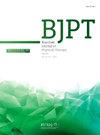Translation, cross-cultural adaptation, and measurement properties of the prolapse and incontinence knowledge quiz (PIKQ-Br) for Brazilian women with urinary incontinence
IF 3.1
3区 医学
Q1 ORTHOPEDICS
引用次数: 0
Abstract
Background
The Prolapse and Incontinence Knowledge Quiz (PIKQ) was developed to assess women's knowledge of pelvic organ prolapse (POP) and urinary incontinence (UI).
Objective
To perform the translation, cross-cultural adaptation, and measurement properties of the PIKQ for Brazilian women with UI (PIKQ-Br).
Methods
The measurement properties were tested for validity (content and face, structural, and hypotheses testing) and reliability (internal consistency, test-retest, and measurement error) in 130 women with UI from Recife, Brazil. Hypotheses testing for construct validity was assessed by Spearman's correlation coefficients. The standard error of measurement and the smallest detectable change were used to determine the measurement error. The structural validity was examined using a confirmatory factor analysis. Test-retest reliability and internal consistency were determined using the intraclass correlation coefficient (ICC) and Cronbach's alpha.
Results
The structural validity was analyzed with a single factor and 12 questions, revealing the goodness-of-fit was inappropriate (TLI=0.60; RMSEA=0.07). The two factors and 10-question version presented adequate values and factor loading (>0.30), except questions 1, 7, and 8 in PIKQ-POP. Positive and moderate correlations for hypotheses testing were observed for PIKQ-UI-10 (rho=0.439). Positive and weak correlations were observed for PIKQ-POP-10 (rho=0.278). Cronbach's alpha coefficients for PIKQ-UI-10 were 0.718 and 0.710 for PIKQ-POP-10. Both scales showed excellent reliability (ICC>0.93). The PIKQ-UI-10 and PIKQ-POP-10 had SEM values of 0.24 and 0.31 and SDC of 0.66 and 0.85, respectively.
Conclusions
The PIKQ-Br with 10 questions and two-factor presented adequate measurement properties, and can be a useful instrument to assess women's knowledge about UI and POP.
巴西女性尿失禁脱垂和尿失禁知识测验(PIKQ-Br)的翻译、跨文化适应和测量特性
背景:脱垂和尿失禁知识测验(PIKQ)旨在评估女性对盆腔器官脱垂(POP)和尿失禁(UI)的知识。目的:研究巴西UI女性PIKQ (PIKQ- br)的翻译、跨文化适应和测量特性。方法:对来自巴西累西腓的130名女性UI患者进行了效度检验(内容和面、结构和假设检验)和信度检验(内部一致性、重测和测量误差)。构念效度的假设检验采用Spearman相关系数进行评估。采用测量标准误差和最小可检测变化来确定测量误差。采用验证性因子分析检验结构效度。采用类内相关系数(ICC)和Cronbach’s alpha测定重测信度和内部一致性。结果:结构效度分析为单因素12题,拟合优度不合适(TLI=0.60;RMSEA = 0.07)。除了PIKQ-POP的1、7、8题外,两个因子和10题版本的值和因子负载都足够(>0.30)。在假设检验中,PIKQ-UI-10呈正相关和中度相关(rho=0.439)。PIKQ-POP-10存在正相关和弱相关(rho=0.278)。PIKQ-UI-10的Cronbach α系数为0.718,PIKQ-POP-10的Cronbach α系数为0.710。两种量表均具有极好的信度(ICC>0.93)。PIKQ-UI-10和PIKQ-POP-10的SEM值分别为0.24和0.31,SDC值分别为0.66和0.85。结论:10题双因子PIKQ-Br量表具有较好的测量性能,可作为评价女性UI和POP知识的有效工具。
本文章由计算机程序翻译,如有差异,请以英文原文为准。
求助全文
约1分钟内获得全文
求助全文
来源期刊
CiteScore
6.10
自引率
8.80%
发文量
53
审稿时长
74 days
期刊介绍:
The Brazilian Journal of Physical Therapy (BJPT) is the official publication of the Brazilian Society of Physical Therapy Research and Graduate Studies (ABRAPG-Ft). It publishes original research articles on topics related to the areas of physical therapy and rehabilitation sciences, including clinical, basic or applied studies on the assessment, prevention, and treatment of movement disorders.

 求助内容:
求助内容: 应助结果提醒方式:
应助结果提醒方式:


